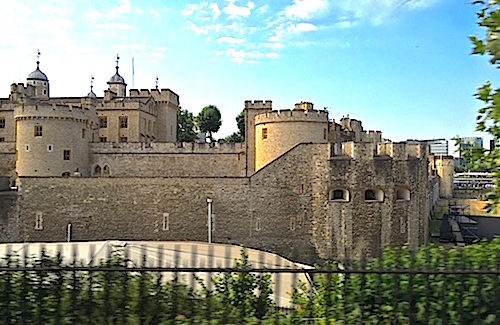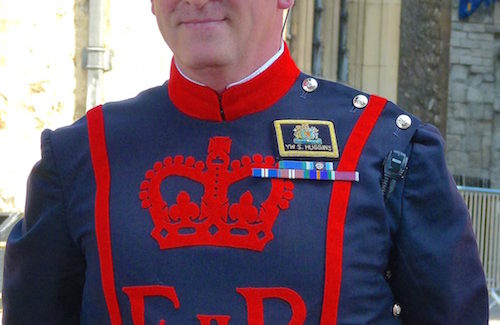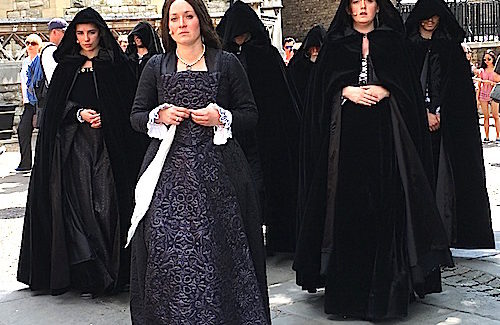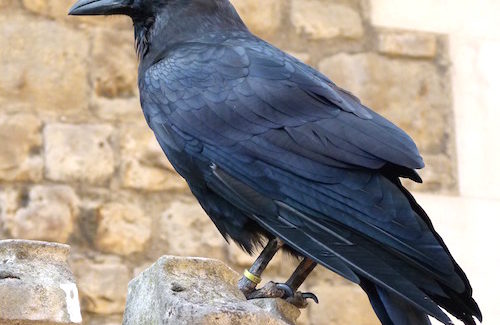Tower of London a forbidding structure
Even the sun seemed to hide when we walked into the Tower of London.
A clear blue sky suddenly darkened and a quick wind ate through my summer shirt.
“It must have been miserable here in the winter,” a fellow traveler said, as we tried to walk a little faster.
I’ll bet it was miserable here anytime. It also was the final residence for many people over the centuries.
For much of its history, the Tower of London was an object of fear. Those who got on the wrong side of the monarch were imprisoned within its dank walls.
Many did not get out alive and were tortured before meeting gory deaths on nearby Tower Hill.
The little princes, Edward and Richard, were said to have been murdered in the Bloody Tower. Sons and heirs of Edward IV, the tale of the two boys is one of the darkest mysteries of the Tower. They were put in the Tower by their uncle, Richard of Gloucester, when their father died in 1483.
Neither child was seen again and Richard was crowned later that year. In 1674, the skeletons of two children were found nearby, which some say solved the mystery of the boys’ disappearance. However, debate and research are still ongoing trying to uncover the truth of the two children’s fate.
But there is no disputing what happened to Anne Boleyn and Catherine Howard. Their heads were chopped off on Tower Green by order of their husband, King Henry VIII.
Sir Walter Raleigh wrote during his imprisonment
Sir Walter Raleigh and his wife Bess spent time here. King James I charged Raleigh with treason and kept him, his family and his servants in the Tower for 12 years. Raleigh stayed busy by writing his “History of the World.”
Raleigh was released in 1616 but couldn’t keep out of trouble. Setting off to find gold in South America, Raleigh’s men disobeyed the king’s order not to attack the Spaniards.
Upon his return to England, Raleigh was sentenced to death in 1618 for disobeying orders. Raleigh met his fate bravely. He joked with the executioner and even gave the signal for the ax to fall.
The last prisoner held in the Tower was Rudolph Hess. The Nazi war criminal was imprisoned in the Tower in 1941 before he was tried at Nuremberg and given a life sentence. Hess died at Spandau Prison in West Berlin in 1987.
Although it is spooky and forbidding, the Tower still was not at all what I expected. Ever since I was old enough to read about such stuff, I had pictured the Tower as a tall structure. In my mind, it was a solitary building arching high into the sky, sort of a place where the fairy tale Rapunzel might have let down her hair.
Well, the Tower of London is definitely scary but it is made up of a whole bunch of towers and other buildings.
From fortress to palace to prison
The world-famous fortress started out as a royal palace built by William the Conqueror in the 11th century. Constructed in 1097, the White Tower at 90 feet high was the tallest building in London. To this day, the White Tower is one of the oldest buildings still standing in London.
Rulers who succeeded William lived in the Tower, along with their armies. Over the years, they expanded on the White Tower, building lots of smaller towers and other fortifications. They also added a stinky moat. Londoners referred to the whole complex as simply the Tower.
The Tower was a safe place for the royal family to live so it only stands to reason that it soon became a secure location to keep prisoners as well. Back then, townspeople had a tendency to try and set prisoners free.
It also was less risky to deliver prisoners to the Tower by the river, instead of parading them through the streets of London. Prisoners could be brought by prison boat to the special dock on the Thames known as Traitor’s Gate.
Just outside the gates of the Tower, Tower Hill became a notorious execution site. Folks would gather hours ahead of the appointed death time to munch on picnic basket goodies and watch a hanging or head chopping.
Tower Green was where the most favored prisoners were executed, away from the ghoulish crowds on Tower Hill. Only seven people died in Tower Green but hundreds more had to bear ghastly public executions.
Spectacular Crown Jewels
As one of the safest places around, the Tower also became the site of the Royal Mint in the 1300s and later the home of the Crown Jewels.
During medieval times, the Crown Jewels were the personal property of the ruler. It was fairly common for the monarch to pawn the Crown Jewels or put them down as security for loans in time of war.
Most of the Crown Jewels date from 1661, when a new set was made for the coronation of Charles II. Parliament had destroyed the previous crowns and scepters after the execution of Charles I in 1649. Only a few pieces survived, hidden by the clergy of Westminster Abbey until the Restoration.
I figured the Crown Jewel display would be a nice exhibit of crowns, scepters, jewelry and other odds and ends. But this is a huge collection — rooms and rooms with plenty of guards.
The Crown Jewels are displayed nicely, along with videos, such as Queen Elizabeth being crowned. The Imperial State Crown gets a lot of use. Containing more than 2,800 diamonds, 273 pearls and other gems, the Imperial State Crown is worn by the Queen at the Opening of Parliament.
Made in 1937, the crown is set with a sapphire in a cross. The gem is said to have been worn in a ring by Edward the Confessor who ruled 1042-1066.
One brilliant eye-catcher is the Scepter of the Cross. This 1660 gem contains the biggest cut diamond in the world, the 530-carat First Star of Africa.
The Jewel House also features a collection of elaborate gold and silver plate. The Exeter Salt is a very grand salt cellar from the days when salt was a valuable commodity. It was given by the citizens of Exeter in west England to Charles II during the 1640s Civil War.
Tower odds and ends
At one time, the Tower also was sort of a royal zoo where the king would keep all kinds of animals that were given to him as gifts from other lands. Roaming the quarters would be lions, leopards, owls, jackals and eagles. A polar bear was chained to a dock and allowed to go fishing in the Thames.
The Tower menagerie began in 1235 and continued to grow until the collection was moved 600 years later to what is now Regents Park Zoo.
Among the most photographed people in London are probably the Yeoman Warders who guard the tower. Also known as “Beefeaters,” the 40 costumed men and women are genuine guards protecting the Crown Jewels and the Tower.
Seems strange but it is considered a great honor to serve the Queen in this capacity. One of the rewards is the privilege of living inside the Tower. The nickname “Beefeaters” is thought to have derived from their position in the Royal Bodyguard, which allowed them to eat as much beef as they wanted from the king’s table.
The Yeoman Warders have been at the Tower since the 14th century. Today they combine their traditional ceremonial role with that of tourist guide. They are very accommodating about posing for pictures and probably decorate millions of tourists’ photo albums and cellphone selfies.
Legend of the ravens
A colony of eight ravens also occupy the Tower. By Royal Decree, the Tower must be home to at least six ravens. They are huge birds, and no wonder because they are so well fed by the Yeoman Warders. Since the reign of King Charles II, the ravens have been protected and pampered by the royal decree to be sure they stay.
The Brits have no desire for the ravens to leave.
An old legend says that if the day ever comes when the ravens fly away from the Tower, the monarchy will end and England will fall.
To decrease the odds of that happening, the ravens have all had their wings slightly clipped. That allows the birds to escape the foxes that like to roam the grounds at night. But the loss of feathers also keeps the ravens from flying away.
To keep them safe from foxes, the ravens are rounded up each night and kept in cages. Knowing that they are going to be fed makes the well-trained ravens happy to report to their caged homes each night.
That makes the ravens the only prisoners left in the Tower of London.
Story and Photos by Jackie Sheckler Finch


















View Recent Comments